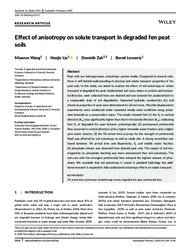Effect of anisotropy on solute transport in degraded fen peat soils
DOI: https://doi.org/10.1002/hyp.13717
Persistent URL: http://resolver.sub.uni-goettingen.de/purl?gldocs-11858/9009
Persistent URL: http://resolver.sub.uni-goettingen.de/purl?gldocs-11858/9009
Wang, Miaorun; Liu, Haojie; Zak, Dominik; Lennartz, Bernd, 2020: Effect of anisotropy on solute transport in degraded fen peat soils. In: Hydrological Processes, Band 34, 9: 2128 - 2138, DOI: 10.1002/hyp.13717.
 |
Dokument öffnen: |
Peat soils are heterogeneous, anisotropic porous media. Compared to mineral soils, there is still limited understanding of physical and solute transport properties of fen peat soils. In this study, we aimed to explore the effect of soil anisotropy on solute transport in degraded fen peat. Undisturbed soil cores, taken in vertical and horizontal direction, were collected from one drained and one restored fen peatland both in a comparable state of soil degradation. Saturated hydraulic conductivity (K
s) and chemical properties of peat were determined for all soil cores. Miscible displacement experiments were conducted under saturated steady state conditions using potassium bromide as a conservative tracer. The results showed that (1) the K
s in vertical direction (K
sv) was significantly higher than that in horizontal direction (Ksh), indicating that K
s of degraded fen peat behaves anisotropically; (2) pronounced preferential flow occurred in vertical direction with a higher immobile water fraction and a higher pore water velocity; (3) the 5% arrival time (a proxy for the strength of preferential flow) was affected by soil anisotropy as well as study site. A strong correlation was found between 5% arrival time and dispersivity, K
s and mobile water fraction; (4) phosphate release was observed from drained peat only. The impact of soil heterogeneity on phosphate leaching was more pronounced than soil anisotropy. The soil core with the strongest preferential flow released the highest amount of phosphate. We conclude that soil anisotropy is crucial in peatland hydrology but additional research is required to fully understand anisotropy effects on solute transport.
Statistik:
ZugriffsstatistikSammlung:
- Geographie, Hydrologie [454]
This is an open access article under the terms of the Creative Commons Attribution License, which permits use, distribution and reproduction in any medium, provided the original work is properly cited.

